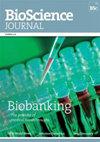Genotypic reaction of chickpea to Fusarium oxysporum and seed sanitary quality
IF 0.6
4区 农林科学
Q3 AGRICULTURE, MULTIDISCIPLINARY
引用次数: 0
Abstract
This research investigated the reaction of chickpea genotypes to Fusarium oxysporum CML 2878, seed health quality, and seed treatment with Carbendazim + Thiram fungicide. The roots of 15-day-old chickpea seedlings were injured, immersed in fungal suspension (4.5 x 107 conidia/mL), and transplanted. Thirty days later, F. oxysporum incidence in the genotypes, pathogenicity, and fresh mass and length of the root and shoot were evaluated. The conducted seed health test followed the incubation methodology on a paper substrate. The seed health and sand emergence tests used a factorial arrangement with two seed treatments (treated with fungicide and untreated) and nine genotypes. Total emergence and the number of normal and abnormal plants were evaluated. All genotypes were susceptible to F. oxysporum CML 2878, thus yellowing and browning the leaves and reducing root development. The primary fungi associated with the seeds of the studied genotypes were Aspergillus sp., Fusarium sp., Rhizopus sp., and Penicillium sp. The fungicide was highly efficient in fungal control but reduced emergence, weight, seedling height, and the number of normal seedlings in the genotypes. This study demonstrated that the evaluated genotypes were susceptible to F. oxysporum CML 2878 and Fusarium sp., spread by seeds. Although fungicidal control was efficient for Fusarium, it may interfere with chickpea germination and vigor.鹰嘴豆对镰孢菌的基因型反应和种子卫生质量
本研究调查了鹰嘴豆基因型对 Fusarium oxysporum CML 2878 的反应、种子健康质量以及使用多菌灵 + Thiram 杀菌剂处理种子的情况。将 15 天大的鹰嘴豆幼苗的根部弄伤,浸入真菌悬浮液(4.5 x 107 分生孢子/毫升)中,然后移植。30 天后,对不同基因型的 F. oxysporum 发生率、致病性、根和芽的新鲜质量和长度进行评估。种子健康试验采用的是在纸基质上培养的方法。种子健康和沙土萌发试验采用因子排列法,有两种种子处理方法(用杀真菌剂处理和未处理)和九种基因型。对总出苗率以及正常和异常植株的数量进行了评估。所有基因型都对 F. oxysporum CML 2878 易感,因此叶片变黄、变褐,根系发育减弱。与所研究基因型种子相关的主要真菌有曲霉菌属、镰刀菌属、根霉菌属和青霉菌属。杀菌剂对真菌的控制效率很高,但会降低基因型的出苗率、重量、苗高和正常苗数。这项研究表明,所评估的基因型对通过种子传播的 F. oxysporum CML 2878 和 Fusarium sp.虽然杀真菌剂对镰刀菌有效,但可能会影响鹰嘴豆的发芽和活力。
本文章由计算机程序翻译,如有差异,请以英文原文为准。
求助全文
约1分钟内获得全文
求助全文
来源期刊

Bioscience Journal
Agricultural and Biological Sciences-General Agricultural and Biological Sciences
CiteScore
1.00
自引率
0.00%
发文量
90
审稿时长
48 weeks
期刊介绍:
The Bioscience Journal is an interdisciplinary electronic journal that publishes scientific articles in the areas of Agricultural Sciences, Biological Sciences and Health Sciences. Its mission is to disseminate new knowledge while contributing to the development of science in the country and in the world. The journal is published in a continuous flow, in English. The opinions and concepts expressed in the published articles are the sole responsibility of their authors.
 求助内容:
求助内容: 应助结果提醒方式:
应助结果提醒方式:


